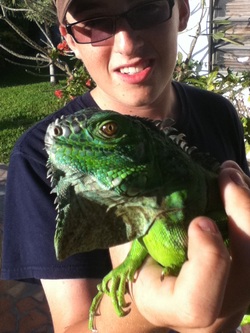 I wanted to show you this green iguana. He's not something you typically will find in North America. I thought, he was kind of neat. They are found in Mexico, Central America and parts of South America. This is a full-grown iguana and is about 5 feet long (including the tail). In addition to it's green color, it has black stripes. Green iguanas, not surprisingly, are green in color, but can be found in many different shades ranging from bright green to a dull grayish green. Their skin is rough, with a set of pointy scales along their back. Green Iguanas have long fingers and claws to help them climb and grasp, like what you see here. Green Iguanas can hear and smell very well, and have superb vision. Their long tail is also quite sharp, and is snapped in the air as a defense mechanism. You can see here, Charlie, is not upset that I am holding him. A green iguana's skin is very water resistant, and tough to avoid cuts and scratches. The color of the skin, helps camouflage him within the foliage. If they need to escape quickly, they have been known to leap from trees into water, and swim do swim well. Both male and female Iguanas can store fat under their jaws and in their necks for times when there is not much food available. Iguanas live in tropical rain forest areas, like Belize. They can be found in lower altitudes in areas near water sources, such as river or streams. They spend most of their time high in the forest canopy, about 40-50 feet above the ground. Iguanas are diurnal, meaning that they are awake during the day. They are cold-blooded, which means they do not produce their own body heat. In other words, a green iguana is cold to the touch. To stay warm, iguanas bask in the sun, lying on warm rocks, as they soak up the sun's heat. Green iguanas tend to live alone, but you may see them in groups occasionally in good sunny basking spots. Iguanas lay eggs, about 50 at a time, in holes in the ground called burrows. After a female iguana lays her eggs, she will leave them and not return. When iguana babies hatch, they grow up without care from their parents. Green iguanas lay many eggs, but only 3-10 babies will actually survive. It takes about 7-10 weeks for an egg to hatch and 2 years for a baby to become an adult. Green iguanas are omnivorous, which means to all you kids, they tend to eat mostly plants, leaves and fruit. Sometimes green iguanas when they are young, will eat eggs, insects and small vertebrates. Tony Garel, at the Belize Zoo & Tropical Education Center, is working on a project to help conserve the iguanas and educate the local communities as to their importance in our environment. Tony has used captive breeding techniques to increase green iguana populations, and has released some of these iguanas into the wild.
3 Comments
|
Trenton Turley
Hi, my name is Trenton S. Turley. I've been living in Belize now for 11 years. Hope you enjoy reading my many blog posts. I write about things, that are passionate to me.
SNAKES OF BELIZE!
Check out, my my current blog series on Snakes of Belize. Categories
All
Archives
April 2016
|

 RSS Feed
RSS Feed